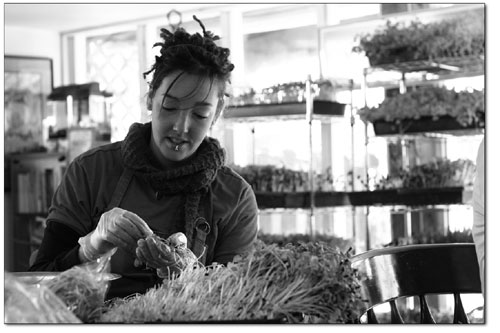|
| ||
| Firming up the local farm SideStory: Home Grown: A Conference on Local Food
by Will Sands The clock could be running backwards, to an era when La Plata County actually supplied much of its own food. Local residents have strong appetites for locally grown foods, and this week Fort Lewis College and the Growing Partners of Southwest Colorado hope to begin to bridge the gap between the local plate and the local grower. Growing Partners of Southwest Colorado is a relatively new, collaborative effort formed with the intent of improving local access to locally grown food. The group has spent the last year and a half trying to tell the story of local foods through a community food assessment. The group’s long-term goal is to better satisfy La Plata County’s craving for foods grown in the community as well as improving local agriculture and making it accessible to all ages, incomes and cultures throughout the community. On Feb. 9 and 10, the Growing Partners and Fort Lewis College hope to bring the local community into that effort. On those two days, people from throughout the area will discuss and debate ways to improve Southwest Colorado’s local food system. The event, “Homegrown: A Conference on Local Food,” will try to get to the heart of the problem – the discrepancy between huge local demand and limited local supply. Marcus Renner, director of the Fort Lewis College Environmental Center, explained, “We have a rapidly emerging market demanding more locally grown food. But we’re struggling with local production for several reasons, including the price of land, the pressure on old operations to sell out and a lack of general knowledge about the emerging market. Finding people who want to farm is also a problem. From our side, Fort Lewis wants to do whatever it can to help with these problems.” One of the highlights of the weekend event will be the release of the year-and-a-half-long community food assessment, which confirms that local food production lags way behind consumer hunger. As mentioned, the cost of real estate is the major obstacle. Shari Fitzgerald, of the Growing Partners, added that there is a lack of infrastructure to support an effective local food network. “We have a really high demand for local food production,” she said. “But the production is not there at this point and a lot of the infrastructure which helps increase production is nonexistent.” Improving the local food system will also require a mental switch on the part of the consumer. Over the last 50-plus years, most Americans have lost connection with their food and assume that the supermarket is the source. Renner said that he hopes the conference will help debunk this persistent myth. “At the broadest, most conceptual level, there’s a lack of knowledge from the consumer on how their food was produced and how it got on the shelf at that particular price,” he said. “That’s nobody’s fault per se, that’s just how the system is set up.” In response, the conference will be serving a “Local Lunch” on Feb. 10, with a listing of the miles traveled by each food item. Because it is early February, not every piece of food at the lunch will be local. For instance, the Local Lunch will serve cheese from the James Ranch, approximately 10 miles from the college. However, Kraft cheese will also be on the menu and determining its mileage was a little more difficult. “We have to ask which Kraft factory shipped the cheese to which distribution center in California, which was then flown to which distribution center in Colorado and trucked how far to Fort Lewis?” Renner asked. “I’m actually glad we’re going to have some Kraft cheese at the lunch to provide that perspective.” Beyond transportation, industrial agriculture presents a host of problems, according to Renner. Genetically modified seeds, pesticides and herbicides, harsh fertilizers and damaging monoculture are all attributes of large-scale farming. La Plata County also learned a hard lesson in late December and early January when storms shut down highways and cut off food shipments from the outside world. “Local food is arguably fresher, healthier and better tasting,” Renner said. “It’s picked when it’s ripe and it gets right to your table. With local food, we can also secure ourselves and buffer against situations like we had last month with the storms and empty shelves.” The future also looks hopeful for local foods according to Fitzgerald and Renner. The efforts of the Growing Partners are starting to build momentum and the group is now looking beyond the problem – high demand and lack of supply – and identifying solutions. The Community Food Assessment has identified various avenues for change, including establishing a distribution, marketing and processing system; offering technical support for farmers; and improving access to agricultural lands, among other things. “Historically, the amount of food production we’ve had shows us there is hope and potential for strengthening local foods,” Fitzgerald said. “Our next step is advocating for change. We’re doing that with this conference, and we want to continue to share that message.” Renner added that he hopes to see immediate outgrowth from this weekend’s conference. “We’re hoping to build support through the conference so that there will be political will for things like preserving our farmland,” he said. “We’re also hoping to attract the grassroots and get people interested in various projects and moving forward in the next five years to make real change. We want the main result of this conference to be action.” And in closing, Renner suggested that La Plata County feeding itself may not be such a stretch after all. “One thousand years ago, in the area around Cortez, archaeologists believe there were 50,000 people living and supporting themselves with agriculture,” he said. “That begs the question that the growing season is too short, and we’re just not capable of growing that much food.” •
|


